
Article republished with permission from Kangaroos Myths and Realities, ISBN 0 9686178 1 3, 2004, available from www.awpc.org.au/ which also contains articles by Professor Peter Singer, Barrister Cliff Papayanni, Dr. Daniel Ramp, Dr. Dror Ben Ami, Dr. John Auty and Kakkib Li’dthia Warrawee’a along with co-editors Maryland Wilson and Dr. David Croft.
Also published as Auty, J., "Red plague grey plague: the kangaroo myths and legends", Australian Mammalogy
26: 33-36, 2004.
Red plague Grey plague
The Kangaroo: Myths and legends
By Dr John Auty
The conventional wisdom is that kangaroo (Macropus spp.) numbers have increased in Australia since European settlement due to cessation of predation by Aborigines and dingoes (Canis lupus dingo), as well as increased availability of water. The historical record shows that at the time of first European contact the kangaroo was numerous and abundant over the continent and Tasmania. The Aborigines were at best poor hunters of kangaroos and quickly incorporated the Europeans’ large hounds into their hunting methodologies. C. l. dingo was a solitary hunter and scavenger. Its lack of capability as a hunter of kangaroos was recognised by the Aborigines who appear to have not used C. l. dingo for this purpose unlike their early use of the Europeans’ kangaroo dogs. Water supplies were largely unimproved by 1860 when Australia de-pastured domestic livestock equivalent to 110 million kangaroos. In 1880 when therewere 240 million kangaroo-equivalents, water supplies had been upgraded only in closely settled areas. It seems probable that at the time of settlement kangaroo numbers exceeded the present population at least threefold.
EXAMINATION of the historical record reveals that kangaroos (Macropus spp.) were widespread in their distribution at the time of European exploration and settlement of Australia and are usually described as being numerous or abundant. This paper reports on a review of records from the 18th and 19th centuries and provides information about the possible numbers of kangaroos during the early years of European exploration and settlement. A previous study by Denny (1980) has shown that kangaroo numbers in New South Wales (NSW) were not as low as commonly assumed. This paper confirms these conclusions.
John White, Chief Surgeon at Sydney (NSW) in 1788 saw kangaroos during local exploratory journeys (White 1962: 129). By 1794 John Macarthur was taking 300 pounds of kangaroo meat a week using one hunter and six greyhounds at Parramatta
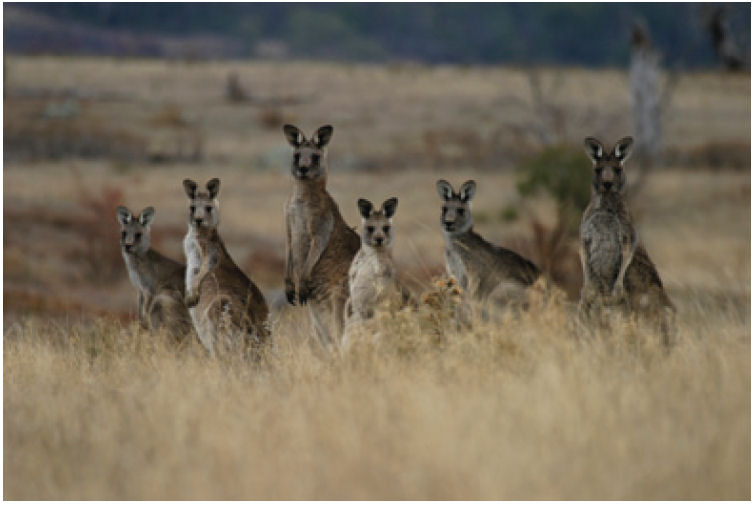
Illustration: Adult and juvenile eastern grey kangaroos seen in abundance by early explorers. (Photo: Bill Corn)
(Onslow 1973: 43). At Sutton Forest to the west of Sydney James Macarthur saw kangaroos in immense flocks in 1821 (Onslow 1973: 371). In Van Diemens Land (Tasmania) kangaroos were harvested for human consumption as early as 1804. The usual means was to hunt them with suitable sight hounds, apparently crosses of the greyhound. Kangaroos were in “abundance” (Historical Records of Australia 1922a: 380). By 1808 hunting pressure had driven the kangaroo into the interior. Hunting and loss of habitat reduced populations to such an extent that in Tasmania the kangaroo was in danger of extinction by 1850. In 1814 G.W. Evans was sent by Governor Macquarie to open a road over the Blue Mountains in NSW. Hoping to victual partly on kangaroos he took hounds. Although he saw numerous kangaroos in his passage the dogs, after suffering wounds, became shy. (Historical Records of Australia 1921: 167). Three years later Evans saw numerous kangaroos on the Lachlan (Historical Records of Australia 1921: 614).
During 1829-1832 a series of explorations were made in the south-west of Western Australia. The explorers recorded “numerous herds of kangaroos” (Cross 1833: 67), “kangaroos and birds in abundance” (Cross 1833: 93), “kangaroos and birds in great abundance” (Cross 1833: 96), “heard kangaroos in the night and found numerous traces of them” (Cross 1833: 113), “saw many large kangaroos on the plain” (Cross 1833: 125), “great numbers of kangaroos” (Cross 1833: 143), “plenty of kangaroos” (Cross 1833: 188), “numerous impressions of the feet of natives and kangaroos” (Cross 1833: 190), “kangaroos ...seemed abundant traces in all places” (Cross 1833: 198), “plenty of kangaroos here without going out of our tract we saw at least twenty” (Cross 1833: 216), “The kangaroo must be very numerous in the interior if we may judge from the quantity seen walking in a straight line” (Cross 1833: 221). In the far north of Western Australia in 1838 George Grey recorded that of all the animals present “kangaroos are alone numerous” (Grey 1841: 239).
In eastern Australia, Mitchell in his journals repeatedly refers to the presence of kangaroos and indeed in three chapter headings records them as “numerous”. He describes the taking of kangaroos by his dogs: on one occasion one dog pulled down four in a short time (Mitchell 1839: 322). After entering Victoria he describes many kangaroos as present about the Loddon River. This was confirmed by the overlander Hawdon (Hawdon 1952: 19) who in 1837 saw kangaroos in “great numbers”. After entering South Australia Hawdon recorded kangaroos as being in “great abundance” and hunted by Europeans for the Adelaide market (Hawdon 1952: 60). At Point Lincoln further to the west Captain Phillip Mitchell recorded in 1836 that kangaroos were in “numerous flocks” (Light 1984: 118).
In 1839-41 Chief Protector Robinson made traverses to the west and north of Melbourne (Victoria). Although he argued that the Aborigines had just cause to kill sheep because they had lost access to their gathering and hunting grounds, he repeatedly reported sightings and taking of kangaroos. Almost every European had a pack of hounds, Robinson noted that “kangaroo dogs are at all the stations” and “there is not a station home or out station but the men and the master have dogs to hunt kangaroos” (Robinson 1980: 111). Hall amongst the first of the overlanders into Garriwerd (the Grampians) in 1841 found kangaroos “abounded” in the forests of the Grampians and that “kangaroo soup, in its abundance, ceased to have any attraction for us” (Bride 1969: 268). Rose an early settler in the Grampians, recorded the kangaroo were still “plentiful at the foot of the mountains” (Bride 1969: 321). Writing of conditions in the 1850s, H.W. Wheelwright hunter, naturalist, and writer knew of no kangaroo-ground within “30 miles” (48.3 km) west of Melbourne. At the same period Wheelwright estimated that his and another party shot at least 2000 kangaroos within a short distance to the south-east of Melbourne (Wheelwright 1979: 19).
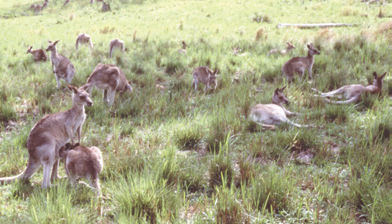
Illustration: The core of the eastern grey kangaroo mob are freely associating female relatives and their offspring. (Photo: Jan Alderhoven))
In south-eastern Queensland Hodgson an early squatter, wrote in 1846 “it is a pitiable fact that in places where I have seen herds of 300 there is not one to be seen now” (Hodgson 1846: 159). Leichhardt took kangaroo dogs on his trip to Port Essington and wrote about the selection of such dogs. The dog “Spring” the only one to survive almost to the end was the means of obtaining “the greatest part of our game” (Leichhardt 1847: 437). He saw flocks of kangaroos on the Burdekin (Leichhardt 1847: 227), and estimated by their tracks on the watershed that they were numerous (Leichhardt 1847: 260). Hovenden Hely a member of Leichhardt’s party to the Victoria
(Barcoo) River recorded “loads” and “hundreds of kangaroos” (Sprod 1989: 271-2).
The Gregorys, explorers and surveyors, made sightings of kangaroos during their traverses to the north-east of Perth (Gregory and Gregory 1884: 9). Sturt is the only one of the early explorers whose records I have examined who did not record sightings. It is to be noted that he spent long periods in incised river beds and he was on the Darling during drought. He sums up: the great kangaroo did not extend beyond latitude 28: whilst the red kangaroo did not extend beyond the Murray and its plains (Sturt 1849). Giles whilst searching for the Finke in the north of South Australia saw “numerous kangaroos” (Giles 1889: 40).
Although most modem commentators write only in general terms about populations of kangaroos at first settlement Tim Flannery (1994) in the Future eaters is more specific. He reveals a lack of knowledge of both the journals of the explorers and the history (timescale) of geographical and faunal exploration. On the basis of a slight review Flannery concludes: “Clearly, red kangaroos were much rarer early last century than they are today” (Flannery 1994: 214). He relies for this finding on his interpretation of the writings of Mitchell, Gould, and Krefft. Thomas Mitchell as shown above described kangaroos as “numerous” over a large area of his travels. When commenting on the lower Darling he makes the point that the absence of kangaroos (and emus Dromaius novaehollandiae) is “sufficient proof of the barrenness of the adjacent country” (Mitchell 1839: 291). The remarks of Gould in the 1840s are irrelevant since at that time the range of the red kangaroo (Macropus rufus) was hardly known, whilst Krefft’s statement of 1862 can be similarly ignored. To sustain his conclusion Flannery must find other authorities.
Predation by Aborigines
Although there is no doubt that Aborigines successfully hunted kangaroos the effects of this hunting by the small Aboriginal population could have had little effect on the large numbers of kangaroos. Grey lists six methods of hunting kangaroos (Grey 1841: 268-274) to which we can add a seventh, hunting with dogs which Grey, and Grey alone and somewhat ambiguously, describes in the Kimberley. Later authors describe two principal methods of hunting: the surround on burnt ground, and the stalk. Both needed large inputs of energy and the former required a substantial gathering of hunters. The burning of scrub and grasslands may in fact have encouraged the growth of kangaroo populations.
That the Aborigine was not wholly satisfied with his own methods of hunting the kangaroo is shown by his eagerness to take up European methods both on the continent and in Tasmania. On the Tasmanian Aborigine Jorgen Jorgenson is worth recording at length (Plomley 1991: 52)
“the natives had no dogs for hunting ... but when they succeeded in stealing dogs ... or otherwise obtained them, the chase became neither so laborious nor so uncertain. They displayed great natural capacity in the training of their dogs, and they treated them more like children than brutes. They were taught not to bark ... in pursuit of game”.
Reporting from Westemport in Port Phillip (Victoria) in 1826, Hovell states the Aborigines “look strong and healthy and live well by means of very fine kangaroo dogs, for which they have plenty of employment, which not only provide them with food but raiment also” (Historical Records of Australia, 1922b: 856. Mitchell (Mitchell 1839: 204) on the Bogan (NSW?) in 1835 comments on the attempt of the Aborigines to steal his dogs after observing their ability to kill kangaroos. He later presented a greyhound pup to the “king” (Mitchell 1839: 241). A year later Darwin on a visit to Bathurst (NSW) wrote that the Aborigines are “always anxious to borrow the dogs from the farmhouses to hunt kangaroos, the kangaroo ... has become scarce ... the English greyhound has been highly destructive” (Darwin 1889: 321). Inland from Shark Bay in Western Australia Gregory in 1858 saw “several large white dogs which were evidently of Australian breed” (Gregory 1884: 42). Whether these were used to hunt kangaroos is unknown.
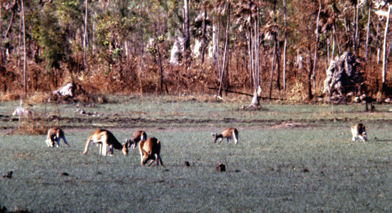
Illustration: A group of antilopine wallaroos, the large kangaroos seen by explorers in northern Australia. (Photo: David B Croft)
Protector Thomas of the Victorian Aborigines Protectorate in 1839 was “much struck” by the care with which the Aborigines at Momington in Victoria cared for their guns (Historical Records of Victoria 1983: 538). Their camp looked like a “butcher shop” (Historical Records of Victoria 1983: 541).
Predation by dingoes
Aborigines at the time of first contact had domesticated dingoes (Canis lupus dingo). Mitchell (1839: 347) wrote, “The Australian natives evince great humanity in their behaviour to these dogs. In the interior, we saw few natives who were not followed by some of these animals, although they did not appear to make much use of them”. They were not used in hunting of kangaroos. The reason is not difficult to find. The kangaroo was a redoubtable fighter. The first European experience of this ability to fight off dogs was a report by White (1962: 147) on a mauling given to a large Newfoundland.
Lieutenant Bradley reported that a kangaroo had taken to the water and tore the pursuing dog so much that the kangaroo had to be despatched. Henderson (1832: 138) records the ability of the large kangaroo species to inflict severe wounds. Dogs which had been bested by a kangaroo were reluctant to be set on thereafter unless in superior numbers. Such reports are commonplace in the literature.
Although the historical record appears to demonstrate that the dingo was the universal dog of Australia, Grey recognised another breed in the Kimberley and described it as follows:
“The new species of dog differs totally from the dingo. ... Its colour is the same as that of the Australian dog in parts having a blackish tinge. The muzzle is narrow, long, thin, and tapers much, resembling that of a greyhound, whilst in general form it approaches the English lurcher. ... I cannot state that I ever saw one wild, or unless in the vicinity of natives” (Grey 1841: 239-40). “The dogs they use in hunting I have already stated to be of a kind unknown in other parts of Australia, and they were never seen wild by us” (Grey 1841:252).
Clearly C. I. dingo might cut off immature, weak, or injured kangaroos but as predators they were outclassed by the ability of the larger macropods to defend themselves. It has been suggested that recent work on canine predation of kangaroos shows that at the present day C. l. dingo is a successful predator of kangaroos (Newsome and Coman 1989: 998). The historical record is unambiguous. I have sighted no observations of the hunting of kangaroos by C. I. dingo. On the other hand the failure of the Aborigines to utilise C. l. dingo to hunt kangaroos whilst quickly availing themselves of the demonstrated ability of the Europeans’ hounds to successfully pull down kangaroos, suggests that Aborigines had little regard for C. I. dingo’s ability as a kangaroo hunter.
Kangaroo numbers at the time of European settlement
Having demonstrated that kangaroos were abundant at the time of European settlement and that Aborigines and C. I. dingo were at best of little consequence as predators, I now address the question of kangaroo numbers in 1788. My base is the capacity of native pasture and scrublands to support introduced herbivores, cattle, sheep, and horses. I allow ten sheep-equivalents to each large stock, and 0.7 sheep to each kangaroo. In 1860 based on the population of introduced herbivores (Chisholm 1963) the kangaroo-equivalent is approximately 110 million, in 1880 240 million. In 1860 settlement had not extended into western Queensland, central and northern Australia, and the central and northern regions of Western Australia (Chisholm 1963) . Water conservation was in its infancy, as was cropping and pasture improvement (Chisholm 1963). In 1880 settlement had barely commenced in western Queensland, central, northern, and north western Australia, some surface water storage and wells had been established, but the artesian and sub-artesian basins were untapped, and pasture improvement and cropping as
known today had hardly commenced (Chisholm 1963).
Conclusions
At first European contact, kangaroos were widely distributed in large numbers over the continent and Tasmania. The Aborigines’ hunting methods were wasteful of energy when compared with those based on hounds as used by the Europeans. Because of this superiority European techniques were quickly copied by the Indigenes. C. l. dingo was a poor predator on kangaroos and for this reason was not used by Aborigines in hunting them. The numbers of kangaroos present in Australia at the time of European settlement can be estimated on the basis of the number of introduced herbivores supported on unimproved pasture and browse.
The population was probably of the order of one to two hundred million.
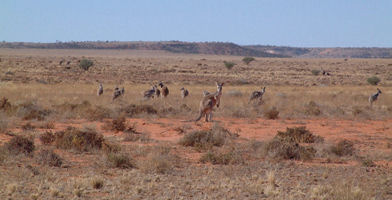
Illustration: Red kangaroos aggregate in loose groups where water runs on to sustain green grasses and herbs. (Photo: David B Croft)
 "Australian Governments (Federal, Territory and State), journalists and cattlemen's associations are attempting to cloud facts about Australia's live export trade, known for at least 18 years: Indonesian halal is intended to inflict pain, employing a slow sawing motion to cut throats, rather than the less-than-a-second two-motion movement used by Australian professionals. Moreover, halal knives are invariably blunt. Even if animal rights were legislated in Indonesia, the Indonesian Government is simply too corrupt to maintain regulatory controls." (Tony Ryan)
"Australian Governments (Federal, Territory and State), journalists and cattlemen's associations are attempting to cloud facts about Australia's live export trade, known for at least 18 years: Indonesian halal is intended to inflict pain, employing a slow sawing motion to cut throats, rather than the less-than-a-second two-motion movement used by Australian professionals. Moreover, halal knives are invariably blunt. Even if animal rights were legislated in Indonesia, the Indonesian Government is simply too corrupt to maintain regulatory controls." (Tony Ryan)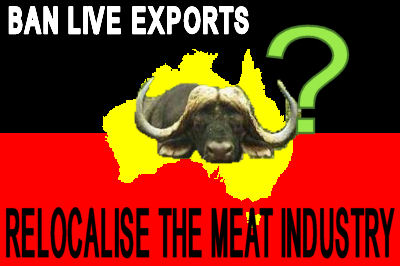


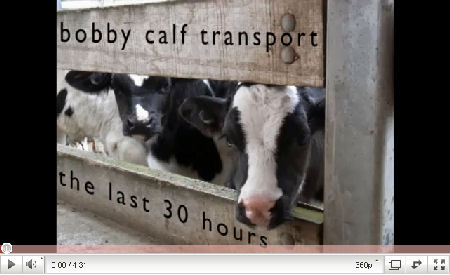 http://www.youtube.com/watch?v=t5xdwrMRNXo
http://www.youtube.com/watch?v=t5xdwrMRNXo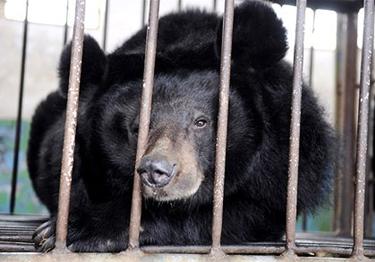

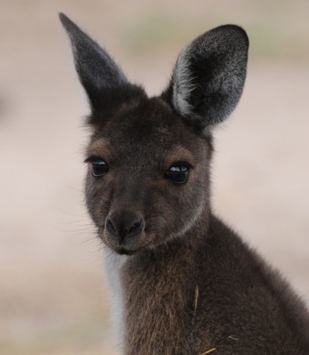
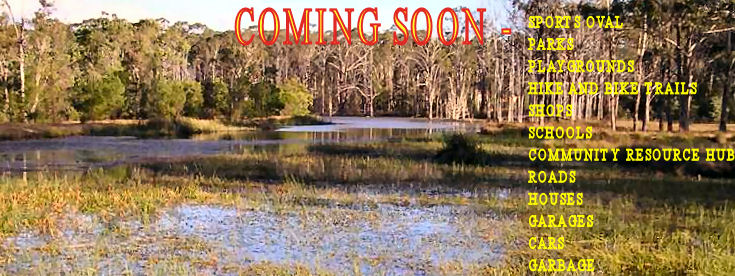



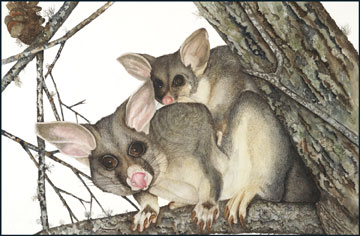
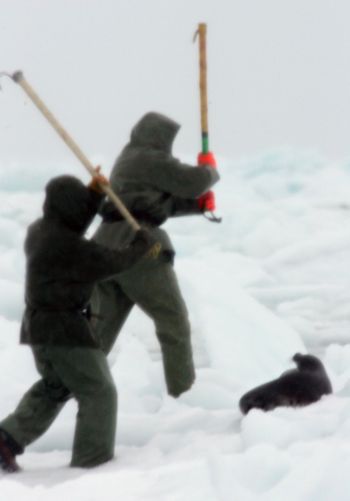
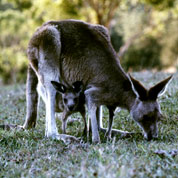
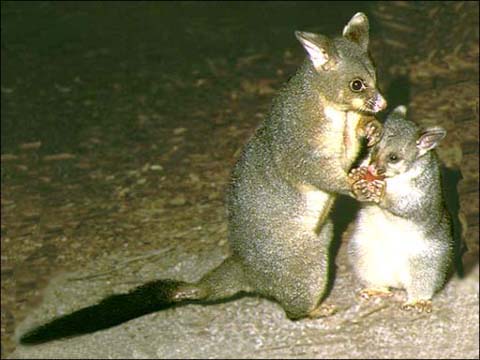


.jpg)

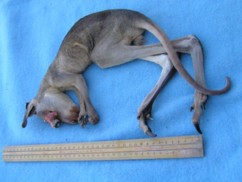 (photo: courtesy of Bernie, from Googong kangaroo massacre, ACT)
(photo: courtesy of Bernie, from Googong kangaroo massacre, ACT) 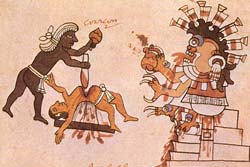

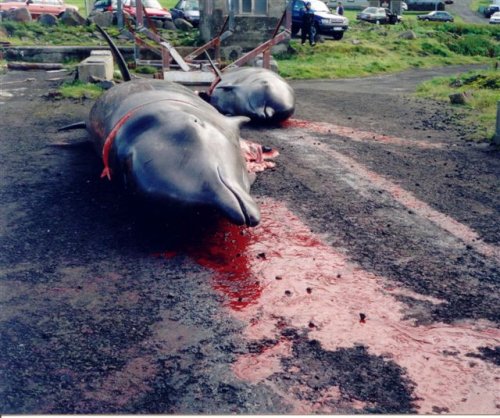
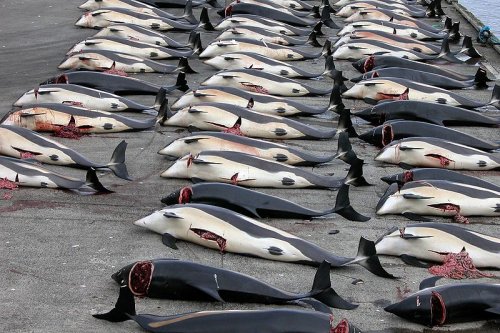
 Hullo Argentina. Look at yourself in this mirror and weep.
Hullo Argentina. Look at yourself in this mirror and weep.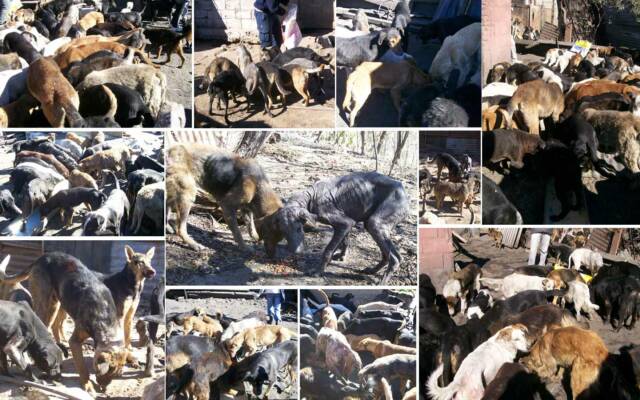

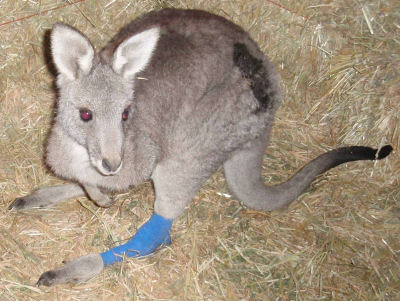
 The first case of H1N1 swine flu virus was discovered in a North Carolina factory farm in 1998, not in Mexico. Within months of the 1998 emergence, the virus showed up in Texas, Minnesota, and Iowa.
The first case of H1N1 swine flu virus was discovered in a North Carolina factory farm in 1998, not in Mexico. Within months of the 1998 emergence, the virus showed up in Texas, Minnesota, and Iowa.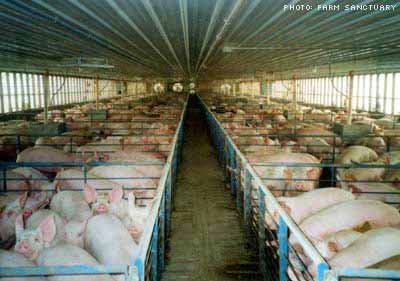 Influenza in pigs is closely correlated with pig density,” said a European Commission-funded researcher studying the situation in Europe.
Influenza in pigs is closely correlated with pig density,” said a European Commission-funded researcher studying the situation in Europe. 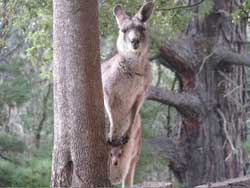







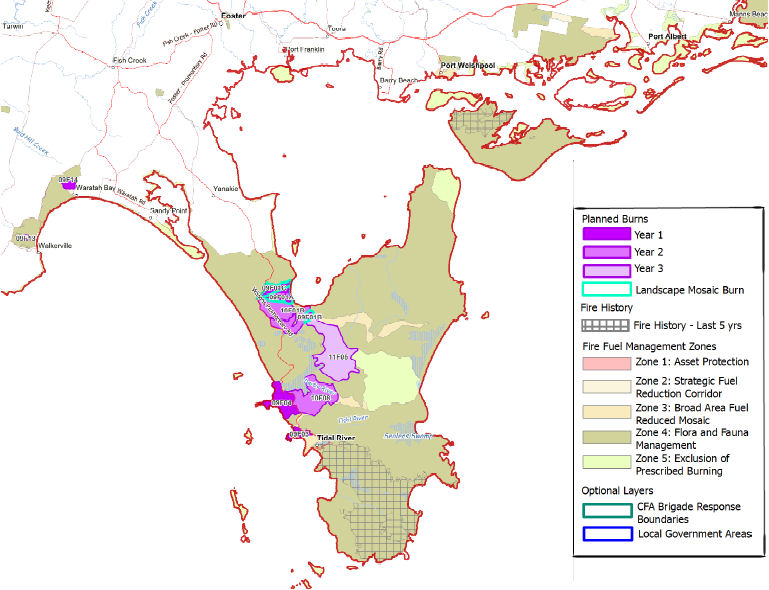
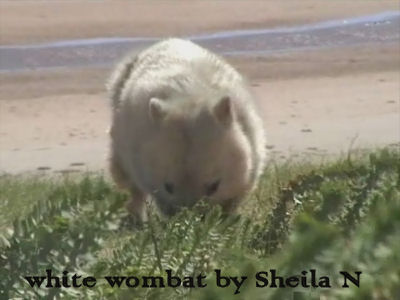
 Since Black Saturday - Feb 7, 2009 - when Australia's worst-ever bushfires on the hottest day in Victoria's recorded history completely destroyed all infrastructure at Wildhaven animal rescue and release center, Alan and Stella Reid have had a few visitors, including Steve Irwin's father, Bob Irwin, and Maryland Wilson of the AWPC, and four kangaroos that also escaped with their lives. Allan Reid tells an incredible story of his own survival as the place burned to the ground leaving him and perhaps four kangaroos alive. Please consider donating money for hay and rebuilding.See also
Since Black Saturday - Feb 7, 2009 - when Australia's worst-ever bushfires on the hottest day in Victoria's recorded history completely destroyed all infrastructure at Wildhaven animal rescue and release center, Alan and Stella Reid have had a few visitors, including Steve Irwin's father, Bob Irwin, and Maryland Wilson of the AWPC, and four kangaroos that also escaped with their lives. Allan Reid tells an incredible story of his own survival as the place burned to the ground leaving him and perhaps four kangaroos alive. Please consider donating money for hay and rebuilding.See also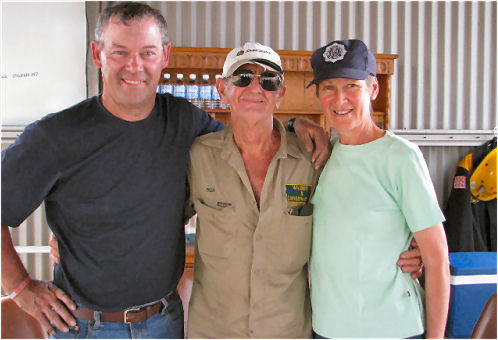

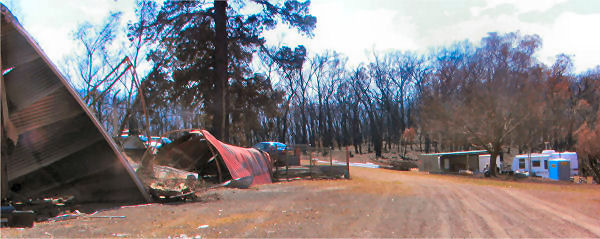
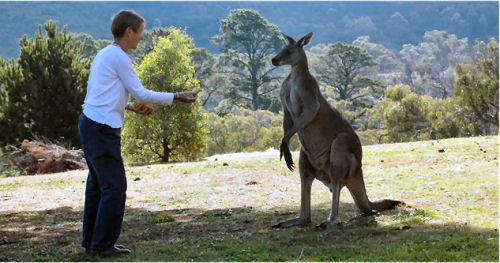 Stella & Boof in happier times
Stella & Boof in happier times



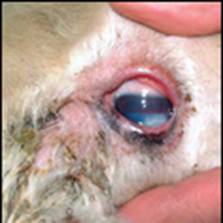

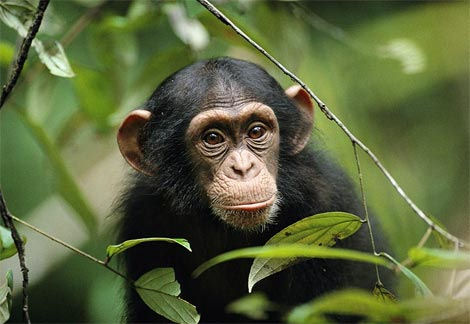

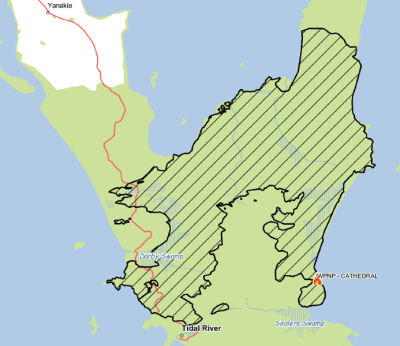
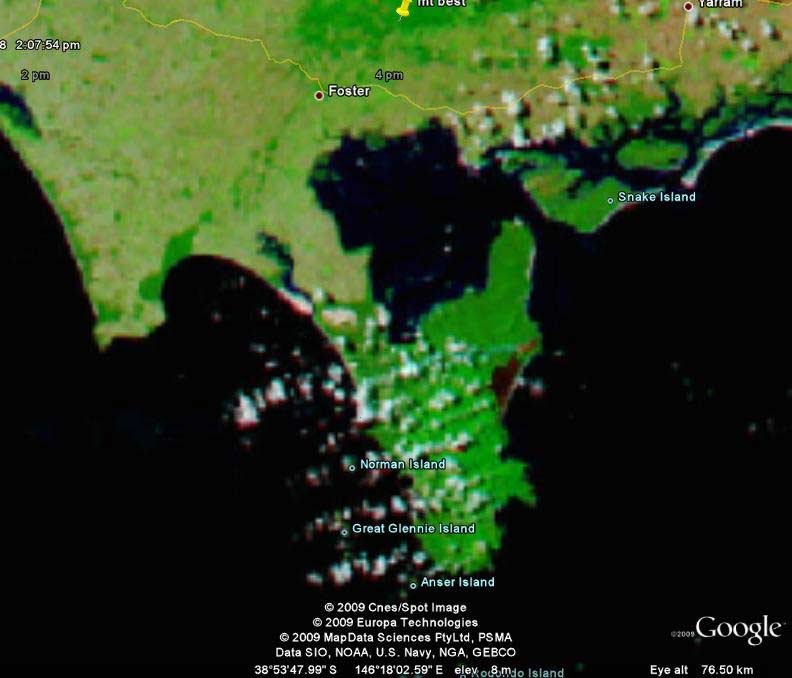

Recent comments